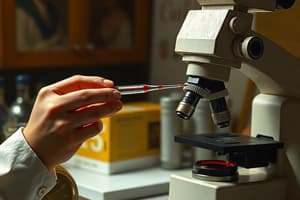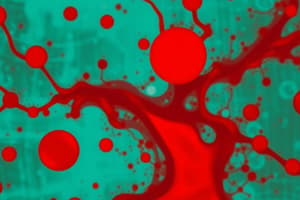Podcast
Questions and Answers
What is a hematocrit?
What is a hematocrit?
Hematocrit is the percentage of erythrocytes in a whole blood sample.
Which of the following is NOT regulated by the blood?
Which of the following is NOT regulated by the blood?
- pH levels
- Oxygen levels
- Nutrient levels (correct)
- Temperature
Which of the following plasma proteins is improperly matched with its function?
Which of the following plasma proteins is improperly matched with its function?
- Albumin: Osmotic pressure
- Alpha globulin: Transport of metal ions and fat-soluble vitamins
- Fibrinogen: Clotting
- Gamma globulins: Lipid transport (correct)
Which plasma constituent is the main contributor to clotting?
Which plasma constituent is the main contributor to clotting?
What is the name of the protein found in erythrocytes that transports respiratory gases?
What is the name of the protein found in erythrocytes that transports respiratory gases?
What triggers erythropoietin (EPO) production to make new red blood cells?
What triggers erythropoietin (EPO) production to make new red blood cells?
Which part of the hemoglobin molecule binds carbon dioxide for transport?
Which part of the hemoglobin molecule binds carbon dioxide for transport?
From which cell do the granulocytes descend?
From which cell do the granulocytes descend?
Which of the following leukocytes is NOT correctly matched with its function?
Which of the following leukocytes is NOT correctly matched with its function?
Hemostasis is important for __________.
Hemostasis is important for __________.
Which ABO blood type is considered to be the universal recipient?
Which ABO blood type is considered to be the universal recipient?
Flashcards are hidden until you start studying
Study Notes
Hematocrit
- Hematocrit represents the ratio of erythrocytes (red blood cells) to the total blood volume, expressed as a percentage.
Blood Regulation
- Blood regulates various parameters, but nutrient levels are NOT among those regulated.
Plasma Proteins and Functions
- Fibrinogen is essential for clotting.
- Gamma globulins primarily function in lipid transport, not clotting.
- Albumin helps maintain osmotic pressure.
- Alpha globulins are involved in transporting metal ions and fat-soluble vitamins.
Clotting Factors
- Fibrinogen is identified as the main plasma component responsible for blood clotting.
Respiratory Gas Transport
- Hemoglobin is the protein in erythrocytes that facilitates the transport of oxygen and carbon dioxide.
Erythropoietin Production
- Erythropoietin (EPO) production is triggered by decreased oxygen availability in the bloodstream, stimulating red blood cell production.
Carbon Dioxide Transport
- The amino acids in the globin portion of hemoglobin are responsible for binding and transporting carbon dioxide.
Granulocyte Origin
- Granulocytes originate from precursor cells known as myeloblasts.
Leukocyte Functions
- Eosinophils are misidentified as bacterial macrophages; they primarily combat parasites and mediate allergic reactions.
- Monocytes differentiate into macrophages, participating in immune defense.
- Lymphocytes are crucial for immune responses, particularly against viral infections.
- Basophils play a role in inflammatory responses.
Hemostasis
- Hemostasis refers to the complex process that prevents and stops bleeding, ensuring the maintenance of blood volume.
Blood Type Compatibility
- The ABO blood type AB is recognized as the universal recipient, capable of receiving blood from any ABO type without an adverse reaction.
Studying That Suits You
Use AI to generate personalized quizzes and flashcards to suit your learning preferences.




